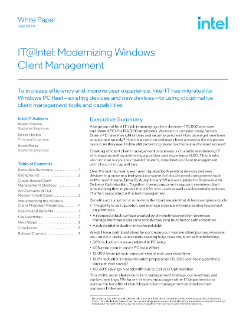Modernizing Windows Client Management
Why is Intel IT modernizing Windows client management? Because a large part of Intel IT’s job is managing client devices—175,000 end-user and shared PCs for 124,000 employees. We need to consider many factors. Does a PC have the right drivers and security patches? How do we get new hires provisioned quickly? How do we ensure end users have access to the corporate resources they need, while still protecting resources from unauthorized access?
Creating efficient client management processes is crucial to maintaining IT efficiency as well as bolstering a positive user experience (UX). That is why we continue our journey toward modern, cloud-native client management with cloud-first capabilities.
Over the last few years, we have migrated both existing devices and new devices to a modern client stack composed of cloud-based components such as Microsoft Intune, Entra ID, Autopilot, and Windows Update for Business with Delivery Optimization. Together, these components support seamless client provisioning that improves the UX for end users as well as substantially reduces IT effort associated with client management.Benefits accruing from the move to the cloud are plentiful. A few examples include:
- The ability to set up, patch, and manage a device without needing to connect on-premises.
- A reduced attack surface created by eliminating several on-premises management tools and consistently requiring multifactor authentication.
- A substantial reduction in technical debt.
We still have additional plans for continuing our modern client journey. However, we—and our users—are already reaping huge rewards, such as the following:
- 38% reduction in issues related to PC setup
- 40% reduction in onsite PC build effort
- 10,000 fewer person-days per year in end-user downtime
- 100% reduction in security patch preparation (10,208 user-facing patching days per year saved)
- 40-60% savings in bandwidth due to Delivery Optimization
This white paper shares our client management strategy, our roadmap, and our key learnings. We hope this story encourages other IT departments to pursue the benefits of cloud-based client management and makes their journey a little easier.
